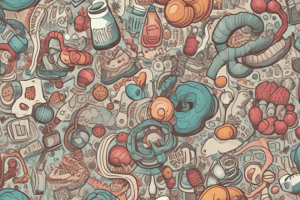Podcast
Questions and Answers
What is the primary role of carbohydrates in cellular functions?
What is the primary role of carbohydrates in cellular functions?
- Providing genetic information
- Serving as a primary source of energy (correct)
- Regulating lipid metabolism
- Facilitating protein synthesis
What is the effect of hydrolysis on carbohydrates?
What is the effect of hydrolysis on carbohydrates?
- It increases the number of glycosidic bonds.
- It creates cellulose from glucose units.
- It separates monosaccharides from polysaccharides. (correct)
- It forms new glycosidic bonds.
How do different isomeric forms of glucose affect their function?
How do different isomeric forms of glucose affect their function?
- They only differ in melting points.
- They vary exclusively in their molecular weight.
- They have identical functions due to similar structures.
- They have different properties and functions. (correct)
What is a consequence of adding functional groups to carbohydrates?
What is a consequence of adding functional groups to carbohydrates?
What is produced as a byproduct during the formation of glycosidic bonds?
What is produced as a byproduct during the formation of glycosidic bonds?
Which of the following statements accurately describes monosaccharides?
Which of the following statements accurately describes monosaccharides?
What is the main difference between starch and cellulose?
What is the main difference between starch and cellulose?
Which carbohydrate is found primarily in fruits and honey?
Which carbohydrate is found primarily in fruits and honey?
What kind of reaction forms a glycosidic bond between two monosaccharides?
What kind of reaction forms a glycosidic bond between two monosaccharides?
All of the following are examples of disaccharides EXCEPT:
All of the following are examples of disaccharides EXCEPT:
Which property of carbohydrates is primarily influenced by the arrangement of atoms in the molecule?
Which property of carbohydrates is primarily influenced by the arrangement of atoms in the molecule?
What is the primary function of glycogen in animals?
What is the primary function of glycogen in animals?
Which property of carbohydrates allows them to dissolve in water?
Which property of carbohydrates allows them to dissolve in water?
Flashcards
Monosaccharides
Monosaccharides
Simple sugars; the simplest carbohydrates that cannot be broken down into smaller carbohydrates.
Disaccharides
Disaccharides
Double sugars; formed by two monosaccharides linked together.
Polysaccharides
Polysaccharides
Complex carbohydrates; formed by many monosaccharides linked together.
Glucose
Glucose
Signup and view all the flashcards
Glycosidic bond
Glycosidic bond
Signup and view all the flashcards
Starch
Starch
Signup and view all the flashcards
Glycogen
Glycogen
Signup and view all the flashcards
Cellulose
Cellulose
Signup and view all the flashcards
Carbohydrate function
Carbohydrate function
Signup and view all the flashcards
Hydrolysis
Hydrolysis
Signup and view all the flashcards
Dehydration synthesis
Dehydration synthesis
Signup and view all the flashcards
Carbohydrate isomers
Carbohydrate isomers
Signup and view all the flashcards
Study Notes
Introduction to Carbohydrates
- Carbohydrates are a class of organic compounds containing carbon, hydrogen, and oxygen.
- The general formula for many carbohydrates is (CH₂O)ₙ, where 'n' represents the number of carbon atoms.
- They are vital for energy storage, structural support, and cellular recognition in living organisms.
- Carbohydrates are broadly classified into monosaccharides, disaccharides, and polysaccharides.
Monosaccharides
- These are the simplest carbohydrates, also known as simple sugars.
- They cannot be hydrolyzed into smaller carbohydrates.
- Examples include glucose, fructose, and galactose.
- Glucose is a crucial energy source for cells.
- Fructose is commonly found in fruits and honey.
- Galactose is a component of lactose (milk sugar).
- Important properties of monosaccharides include their ability to form cyclic structures.
- The presence of hydroxyl groups (-OH) gives rise to isomeric forms (like alpha & beta glucose).
Disaccharides
- Composed of two monosaccharide units linked together by a glycosidic bond, formed via a dehydration reaction.
- Examples include sucrose, lactose, and maltose.
- Sucrose is table sugar, linking glucose and fructose together.
- Lactose is the primary sugar in milk, consisting of glucose and galactose.
- Maltose is composed of two glucose molecules.
Polysaccharides
- Large polymers composed of many monosaccharide units linked together via glycosidic bonds.
- Examples include starch, glycogen, and cellulose.
- Starch is the primary energy storage polymer in plants.
- Glycogen is the primary energy storage polymer in animals.
- Cellulose is the primary structural component of plant cell walls.
- Starch and glycogen are both composed of glucose units linked together in a similar manner, but the structural differences influence their solubility and function.
- Cellulose differs significantly because its glucose units are linked in a different configuration, creating a rigid, fibrous structure.
Properties of Carbohydrates
- Many carbohydrates are soluble in water due to numerous hydroxyl groups that form hydrogen bonds with water molecules.
- The specific arrangement of atoms in the molecule dictates the carbohydrate's particular properties (like sweetness, solubility, and structural rigidity).
- The presence or absence of reducing groups can influence the chemical behavior of the carbohydrate.
- The type and number of glycosidic bonds between monosaccharide units are crucial for defining the structure and function of the polysaccharide.
Importance in Biochemistry and Biology
- Carbohydrates play a vital role in energy production, storage, and cellular recognition.
- They serve as a primary source of readily available energy for cells.
- They are also involved in cell-cell interactions and recognition processes.
- Structural components like cellulose are crucial for providing rigidity and support to plant cell walls.
- Some carbohydrates act as signaling molecules, mediating cellular responses.
Key Reactions
- Hydrolysis is a crucial reaction where glycosidic bonds are broken by the addition of water, resulting in the release of monosaccharides from disaccharides or polysaccharides.
- Dehydration reactions are important in the synthesis of disaccharides and polysaccharides where water is a byproduct of the bond formation.
Modifications of Carbohydrates
- Carbohydrates can be modified by the addition of other functional groups or by phosphorylation, which can alter their properties and functions.
Types of Isomers
- Different spatial arrangements of atoms within a molecule can create isomeric forms like alpha and beta glucose.
- The isomers have different properties and functions because of differing spatial arrangements.
Studying That Suits You
Use AI to generate personalized quizzes and flashcards to suit your learning preferences.
Description
Test your knowledge on the fundamental aspects of carbohydrates, including their classification, structure, and examples. This quiz covers monosaccharides, disaccharides, and their importance in biological systems.




